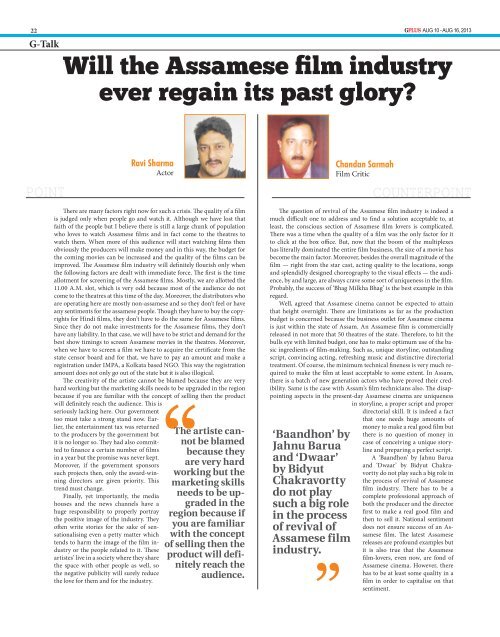You also want an ePaper? Increase the reach of your titles
YUMPU automatically turns print PDFs into web optimized ePapers that Google loves.
22<br />
G-Talk<br />
POINT<br />
GPLUS AUG 10 - AUG 16, 2013<br />
Will the Assamese film industry<br />
ever regain its past glory?<br />
Ravi Sharma<br />
Actor<br />
There are many factors right now for such a crisis. The quality of a film<br />
is judged only when people go and watch it. Although we have lost that<br />
faith of the people but I believe there is still a large chunk of population<br />
who loves to watch Assamese films and in fact come to the theatres to<br />
watch them. When more of this audience will start watching films then<br />
obviously the producers will make money and in this way, the budget for<br />
the coming movies can be increased and the quality of the films can be<br />
improved. The Assamese film industry will definitely flourish only when<br />
the following factors are dealt with immediate force. The first is the time<br />
allotment for screening of the Assamese films. Mostly, we are allotted the<br />
11.00 A.M. slot, which is very odd because most of the audience do not<br />
come to the theatres at this time of the day. Moreover, the distributors who<br />
are operating here are mostly non-assamese and so they don’t feel or have<br />
any sentiments for the assamese people. Though they have to buy the copyrights<br />
for Hindi films, they don’t have to do the same for Assamese films.<br />
Since they do not make investments for the Assamese films, they don’t<br />
have any liability. In that case, we will have to be strict and demand for the<br />
best show timings to screen Assamese movies in the theatres. Moreover,<br />
when we have to screen a film we have to acquire the certificate from the<br />
state censor board and for that, we have to pay an amount and make a<br />
registration under IMPA, a Kolkata based NGO. This way the registration<br />
amount does not only go out of the state but it is also illogical.<br />
The creativity of the artiste cannot be blamed because they are very<br />
hard working but the marketing skills needs to be upgraded in the region<br />
because if you are familiar with the concept of selling then the product<br />
will definitely reach the audience. This is<br />
seriously lacking here. Our government<br />
too must take a strong stand now. Ear-<br />
lier, the entertainment tax was returned<br />
to the producers by the government but<br />
it is no longer so. They had also committed<br />
to finance a certain number of films<br />
in a year but the promise was never kept.<br />
Moreover, if the government sponsors<br />
such projects then, only the award-winning<br />
directors are given priority. This<br />
trend must change.<br />
Finally, yet importantly, the media<br />
houses and the news channels have a<br />
huge responsibility to properly portray<br />
the positive image of the industry. They<br />
often write stories for the sake of sensationalising<br />
even a petty matter which<br />
tends to harm the image of the film industry<br />
or the people related to it. These<br />
artistes’ live in a society where they share<br />
the space with other people as well, so<br />
the negative publicity will surely reduce<br />
the love for them and for the industry.<br />
“<br />
The artiste cannot<br />
be blamed<br />
because they<br />
are very hard<br />
working but the<br />
marketing skills<br />
needs to be upgraded<br />
in the<br />
region because if<br />
you are familiar<br />
with the concept<br />
of selling then the<br />
product will definitely<br />
reach the<br />
audience.<br />
Chandan Sarmah<br />
Film Critic<br />
COUNTERPOINT<br />
The question of revival of the Assamese film industry is indeed a<br />
much difficult one to address and to find a solution acceptable to, at<br />
least, the conscious section of Assamese film lovers is complicated.<br />
There was a time when the quality of a film was the only factor for it<br />
to click at the box office. But, now that the boom of the multiplexes<br />
has literally dominated the entire film business, the size of a movie has<br />
become the main factor. Moreover, besides the overall magnitude of the<br />
film — right from the star cast, acting quality to the locations, songs<br />
and splendidly designed choreography to the visual effects — the audience,<br />
by and large, are always crave some sort of uniqueness in the film.<br />
Probably, the success of ‘Bhag Milkha Bhag’ is the best example in this<br />
regard.<br />
Well, agreed that Assamese cinema cannot be expected to attain<br />
that height overnight. There are limitations as far as the production<br />
budget is concerned because the business outlet for Assamese cinema<br />
is just within the state of Assam. An Assamese film is commercially<br />
released in not more that 50 theatres of the state. Therefore, to hit the<br />
bulls eye with limited budget, one has to make optimum use of the basic<br />
ingredients of film-making. Such as, unique storyline, outstanding<br />
script, convincing acting, refreshing music and distinctive directorial<br />
treatment. Of course, the minimum technical fineness is very much required<br />
to make the film at least acceptable to some extent. In Assam,<br />
there is a batch of new generation actors who have proved their credibility.<br />
Same is the case with Assam’s film technicians also. The disappointing<br />
aspects in the present-day Assamese cinema are uniqueness<br />
in storyline, a proper script and proper<br />
directorial skill. It is indeed a fact<br />
that one needs huge amounts of<br />
money to make a real good film but<br />
‘baandhon’ by<br />
jahnu barua<br />
and ‘Dwaar’<br />
by bidyut<br />
Chakravortty<br />
do not play<br />
such a big role<br />
in the process<br />
of revival of<br />
assamese film<br />
industry.<br />
“<br />
there is no question of money in<br />
case of conceiving a unique storyline<br />
and preparing a perfect script.<br />
A ‘Baandhon’ by Jahnu Barua<br />
and ‘Dwaar’ by Bidyut Chakravortty<br />
do not play such a big role in<br />
the process of revival of Assamese<br />
film industry. There has to be a<br />
complete professional approach of<br />
both the producer and the director<br />
first to make a real good film and<br />
then to sell it. National sentiment<br />
does not ensure success of an Assamese<br />
film. The latest Assamese<br />
releases are profound examples but<br />
it is also true that the Assamese<br />
film-lovers, even now, are fond of<br />
Assamese cinema. However, there<br />
has to be at least some quality in a<br />
film in order to capitalise on that<br />
sentiment.

















